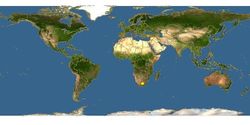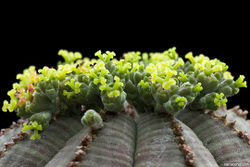Baseball plant
| Baseball plant |
|---|

|
| Scientific Classification |
|
| Scientific Name |
|
Euphorbia obesa |
| Image Description |
The Baseball Plant is a species of flowering succulent known by the scientific name Euphrobia obesa. It gets the name "Baseball Plant" from it being spherical when young but then overtime it get more cylindrical. It was first discovered by Peter MacOwan in 1897 and is an endemic species that is found near the city of Kendrew, of a small area of the Great Karoo, which is located in South Africa. It is very rare and there was concern over it going extinct, but has become a popular ornamental decoration with its beautiful cyathia. .[1]
Body Design
The Baseball plant looks like a green ball and which is why it is called the baseball plant. Its length is about 6 to 15 centimeters and they get bigger as time goes on.[2] When the baseball plants are first grown, they are very round but over time, it starts to get taller and less chunky. Also, like cacti, this plant has its own water reservoir if it is ever about to die. It always has 8 ridged spine things with a lump on the side and edges. In the wild, and with exposure to direct sunlight, it shows red and purple areas.[2] They have tubercles at the center of there spines and that's where the flowers grow from.
The stems of the plant have very thin and purplish ridges that become more unique when the plant more matures and live more in the sun. The stems of this species comes the closest to a perfectly spherical ball of all of the succulents, earning its common name, the "Baseball Plant". The stems are pretty small and they grow up to 4 cm in diameter. And with age the plant becomes more columnar or thinner. There have been records of this plant growing up to 20 inches in diameter which is gigantic for this plant. They typically remains un-branched, remaining compact throughout its life, making it especially suited for growers with limited space. Baseball plants produces a milky latex, possibly causing skin irritation if the latex should come into contact with it - and it may possibly be toxic if accidentally ingested, so the "Baseball Plant" may not be suitable for every household, but it is a deservedly popular plant, a good introductory species for growers who have not yet grown euphorbias. [3]
Life Cycle
These plants are easy to grow but they are very rare. But in habitat, Baseball plants frequently grows under larger shrubs, and may be better adapted to, or are at least tolerant of conditions of shade. It's best grown as a pot plant in a sunny position such as a window sill but can also be grown out of doors in the Karoo and other desert gardens where it isn't cold. It does best in a gravely rocky based soil, but is tolerant of a wide range of soil types. Good drainage is essential. Water sparingly during the summer months and keep dry in winter. It is a slow growing long lived plant and once established, it will be content in its position and with its soil for years. It can tolerate moderate shade, and a plant that has been growing in shade should be slowly hardened off before placing it in full sun as the plant will be severely scorched if moved too suddenly from shade into sun.[1]
For this organism to have a good life, you need to give it a bunch of shade and a bunch of water.[1]
Ecology
The Baseball plant is very rare and is found mostly in Great Karoo, south of Graaff-Reinet in the Eastern Cape. It lives in very hot conditions and it is able to stay alive due to its foundation of water in it. It has to hold water for it to live a healthy life. The plants occur in karoo vegetation among Beaufort shale fragments, where they grow in full sun or in the partial shade provided by dwarf karoo shrubs. They can camouflaged and are very difficult for predators to see. They usually live on stony areas or hilly areas. Summers are very hot: the average daily maximum about 26 degrees centigrade and the minimum about 11 degrees centigrade. And a thing called light frost occurs during the several cold months.[1]
They are found growing in full sun or (more frequently) under the protection of low shrubs and sometime among small but long rocks or in fairly sandy soils. They blend in with the environment so good, its hard to differentiate between different species. They are found 300 to 900 meters above sea level where there is no cold air. They live in very stony and hilly areas with summer rainfall ranging from 200-300 mm per annum, falling mainly in thunder showers. Since this plant basically lives in Africa, the climate is always hot and dry. So the temperature is always really high and the plant will most likely never die from cold weather.[4]
The Cyathia
As with most members of the Euphorbia family, the flowering structures (properly called the cyathia) of Baseball plants are tiny, and are produced at or near the growing apex of the plant. But if you are looking for a plant with large and exceptionally beautiful flowers, this will not be the plant for you. Male and female cyathia are produced on separate plants, so in order to produce viable seed, at least two plants (one of each gender) are necessary. "Male" plants produce cyathia which bear anthers and pollen, while the "female" plants produce cyathia which bear stigmas, and the seed bearing fruits. The mature fruits of Euphorbias are dry capsules, each containing up to 3 seeds. The capsules burst when the seeds ripen, scattering them up to several yards. Many growers contrived elaborate traps to capture these seed when their capsules burst, as collecting the seed too early (before the capsules became sufficiently dry) would result in extremely low germination rates.[3]
Video
References
- ↑ 1.0 1.1 1.2 1.3 Jaarsveld,, Ernst van. [1] PZA Sanbi. Web. Publication, February 2002.
- ↑ 2.0 2.1 [2] eol. Web. Last Modified, 4 years ago, Author Unknown
- ↑ 3.0 3.1 Brethauer , Bruce. [3] Columbus Cactus Club. Web. Accessed, January 25th, 2018.
- ↑ [4] Cactus Art Biz. Web.Accessed February 1st, 2018.Author Unknown.




